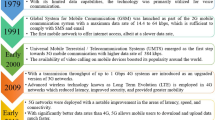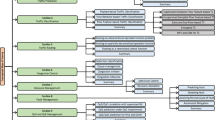Abstract
Most of literature assumed infinite buffer for users, which, however, is not practical in real networks. In this paper, we investigate downlink resource scheduling with constrained queueing. We first formulate an optimization model with the objective of maximizing the system rate under a limited queue length. Then two scheduling methods are proposed to solve this problem. One scheme is based on a virtual alarming threshold; the other is a prediction-based scheme. However, they still suffer from unfairness among rate allocations. To improve performance with respect to rate fairness, the factor of rate fairness is introduced into this optimization formulation finally. Numerical results are presented to demonstrate the efficiency of the proposed scheduling methods in terms of average system rate, maximum queue length and rate fairness, compared to some existing methods.



















Similar content being viewed by others
Notes
Although we here assume that the number of future slots is fixed, results can be easily adjusted to different number of future slots, which is determined by the specific channel prediction method.
References
Andrews, M., Kumaran, K., Ramanan, K., et al. (2001). Providing quality of service over a shared wireless link. IEEE Communications Magazine, 39, 150–154.
Tse, D. N. C., & Hanly, S. V. (1998). Multiaccess fading channels. I. Polymatroid structure, optimal resource allocation and throughput capacities. IEEE Transactions on Information Theory, 44, 2796–2815.
Shariat, M., Quddus, A., Ghorashi, S., et al. (2009). Scheduling as an important cross-layer operation for emerging broadband wireless systems. IEEE Communications Surveys and Tutorials, 11, 74–86.
Shakkottai, S., Rappaport, T. S., & Karlsson, P. C. (2003). Cross layer design for wireless networks. IEEE Communications Magazine, 41, 74–80.
Tassiulas, L., & Ephremides, A. (1992). Stability properties of constrained queueing systems and scheduling policies for maximum throughput in multihop radio networks. IEEE Transactions on Automatic Control, 37, 1936–1948.
Eryilmaz, A., & Srikant, R. (2007). Fair resource allocation in wireless networks using queue-length-based scheduling and congestion control. IEEE/ACM Transactions on Networking, 15(6), 1333–1344.
Fathi, M., Taheri, H., & Mehrjoo, M. (2012). Utility maximisation in channel-aware and queue-aware orthogonal frequency division multiple access scheduling based on arrival rate control. IET Communications, 6(2), 235–241.
Salem, M., Adinoyi, A., Rahman, M., et al. (2010). Fairness-aware radio resource management in downlink OFDMA cellular relay networks. IEEE Transactions on Wireless Communications, 9, 1628–1639.
Salem, M., Adinoyi, A., Yanikomeroglu, H., & Falconer, D. (2011). Fair resource allocation toward ubiquitous coverage in OFDMA-based cellular relay networks with asymmetric traffic. IEEE Transactions on Vehicular Technology, 60, 2280–2292.
Love, D. J., Heath, R. W., Lau, V. K. N., et al. (2008). An overview of limited feedback in wireless communication systems. IEEE Journal on Selected Areas in Communications, 26(8), 1341–1365.
Zhang, P., Xu, Z., Wang, F., et al. (2009). A relay assignment algorithm with interference mitigation for cooperative communication. IEEE Wireless Communications and Networking Conference (WCNC) pp. 1–6.
Duel-Hallen, A., Hallen, H., & Yang, T. (2006). Long range prediction and reduced feedback for mobile radio adaptive OFDM systems. IEEE Transactionson Wireless Communications, 5(10), 2723–2733.
Zhou, S., & Giannakis, G. B. (2004). How accurate channel prediction needs to be for transmit-beamforming with adaptive modulation over Rayleigh MIMO channels? IEEE Transactions on Wireless Communications, 3(4), 1285–1294.
Vicario, J. L., & Antn-Haro, C. (2006). Analytical assessment of multi-user vs. spatial diversity trade-offs with delayed channel state information. IEEE Communications Letters, 10(8), 588–590.
Kuhn, H. W. (1955). The Hungarian method for the assignment problem. Naval Research Logistic Quarterly, 2, 83–97.
Moretti, M., & Todini, A. (2007). A resource allocator for the uplink of multi-cell OFDMA systems. IEEE Transactions on Wireless Communications, 6, 2807–2812.
Jafari, S. M., & Meybodi, M. (2011). Bandwidth allocation in WiMAX networks using learning automaton. World Applied Sciences Journal, 15, 576–583.
Acknowledgments
This work was supported by the Key Project of State Key Laboratory of Rail Traffic and Control under Grant number RCS2012ZZ004 and the Fundamental Research Funds for the Central Universities under Grant number 2013YJS025.
Author information
Authors and Affiliations
Corresponding author
Appendices
Appendix A: Derivation of Lemma 1
Observed by the evolution principle of queue length based on (6), the system will be stable if the queue length is below the maximum allowed queue length after a series of scheduling. But once the number of users goes beyond a certain value, the system would be unstable even if the perfect scheduling is executed. Thus, given \(Q_{max}\) and \(\mu _{max}\), we need to find the upper bound of the number of users access the network, which should satisfy:
Therefore, we can get \(K\le \frac{Q_{max}}{\mu _{max} T}\).
Appendix B: Derivation of Lemma 2
Given the arrival data rate for each user and the number of users \(K\) access the network, there is a requirement for the minimum transmission rate for each user. If the transmission rate is below a certain level, the queue length would be not under control, leading to the unstable system. We consider the worst case here, where the queue lengths for all users will simultaneously exceed the given threshold (\(G\)) at the next scheduling period. Obviously, as long as the worst case is met, the system may be stable under this rate region if the suitable scheduling is employed. The current queue length (\(Q_{k}(l)\)) for each user is assumed as \(G-\varepsilon \), where \(\varepsilon \) is a small positive number. Therefore, the queue lengths of all users at the next scheduling period will exceed \(G\) simultaneously. Then a simple scheduling scheme (like round-robin scheduling) is employed, where all users are scheduled in turn. In order to prevent the queue length of any user growing too fast, the queue length of the last scheduled user after \(K\) scheduling periods (\(Q_{k}(l+K)\)) should be at least the same queue length with the original one (\(Q_{k}(l)\)). Otherwise, the queue length will increase without limitation, and ultimately lead to system instability. We can express the queue evolution for the last scheduled user as:
According to the analysis above, the queue length of the last scheduled user should also satisfy to maintain the system stability:
Through simple calculations, we can get \(r_k\ge K\mu _{max}, k\in \{1,2,...,K\}\).
Rights and permissions
About this article
Cite this article
Wu, D., Zhu, G. & Ai, B. Network Performance Optimization in Constrained Queueing Systems. Wireless Pers Commun 72, 1023–1042 (2013). https://doi.org/10.1007/s11277-013-1053-8
Published:
Issue Date:
DOI: https://doi.org/10.1007/s11277-013-1053-8




